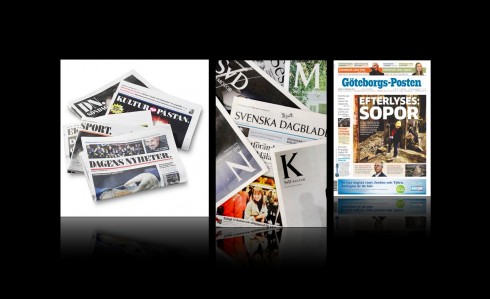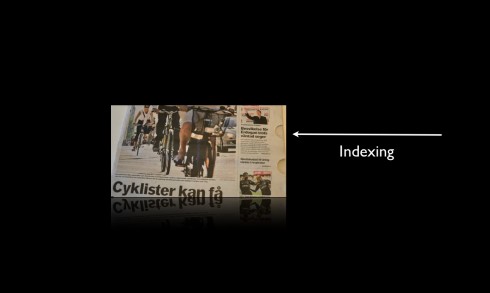TAKEAWAY: It is a good sign that publishers of American newspapers are taking a serious look at strategies that will allow them to switch from the broadsheet to the tabloid format. It could make all the difference. All we need is the first major metropolitan U.S. daily to make the switch, and the others will follow. Let’s not drop the broadsheet versus tabloid dialog this time. There is much at stake and some good solutions at hand.

The majority of Sweden’s newspapers are in compact formats as seen here (l-r): Dagens Nyheter, Svenska Dagbladet, Goteborgs Posten
It is a conversation that emerges from time to time: American newspapers converting to compact formats.
We have heard rumors of this newspaper or that newspaper moving to a tabloid format since the early part of this decade. But more recently, conversations have taken on a more serious, urgent tone.
It is all about the benefits that compact formats can provide to beleaguered American broadsheets. The benefits come from better reader acceptance and lower production and distribution costs.
Types of compact formats
There are several types of compacts formats – Tabloid, Berliner and Micro/A4. Of the three, the tabloid format is most suitable for American newspapers because it can be produced on existing presses, and has a proven track-record of success. Berliner and Micro basically require new presses.
There are two basic ways to produce tabloid formats. The most common is to print tabloid newspapers on current presses, using stitched sections, which has been adopted by many successful European and international newspapers. The other approach involves the three-around press concept developed by Pressline and GOSS to convert standard two-around presses to enable them to print three shorter broadsheet sections per cylinder revolution. It basically changes the cut off of the press making the newspaper shorter. The production method is the same as a broadsheet so there are limited possibilities for stitching. However, Goss International says it overcomes barriers deterring many newspapers from converting to more attractive and cost-effective compact formats, while still accepting standard-sized inserts.
The present economy and the continuing declines in newspaper circulations tend to favor this strategic move to compact. I, and many industry experts believe this could represent one of the biggest changes ever for US newspapers since the arrival of color.
While European newspapers have moved steadily towards the compact format in the past eight years, there has been less enthusiasm on the part of US newspapers to make the switch. There have been some tentative moves from broadsheet to tabloid, including the Bakersfield Californian, the St. Louis Post-Dispatch (Saturday edition), The Jersey Journal and three of Freedom’s North Carolina newspapers (Jacksonville, Kinston and New Bern).
The Canadian tabloid landscape
It’s interesting to note that about ten former Canadian broadsheet newspapers have converted to tabloid format in the last five to ten years. These recent Canadian format conversions do not include Quebecor’s 10 Sun Media “conventional” tabloids, or the 15 free dailies (Metro or 24 Hours) which circulate in many large Canadian cities.
Research and actual results also prove that readers prefer the smaller formats.
In 2005, I authored a white paper, The Impact of the Compact, available for free download on Issuu.com (like Pure Design), in which I presented a detailed account of the smaller formats and their benefits. Like other industry partners, I am concerned that not much has happened in terms of converting the unmanageable and outdated broadsheets to compact formats in the U.S. But I am hopeful that this time around the factors will be more favorable for such changes.
The Scandinavian Compact
Because of my interest in these possible conversions, and knowing how Scandnavian newspapers have made the switch to compact successfully, I turned to Jan Melin, CEO of Tolerans, the premier stitching company based in Stockholm. Tolerans has been deeply involved in the growing wave of European compact conversions.
What is the Scandinavian Compact?
Let’s start by saying that in Sweden, for example, almost all newspapers are stitched tabloids, many with individual stitched sections. I have personally been involved with the conversion of the Goteborgs Posten from broadsheet to tabloid.
To hear Melin explain it:
Tolerans can together with our partner Masthead (a major press re-builder based in Phoenix) provide to US newspapers the key technology for cost-effective press conversion from broadsheet to stitched compact format. We have developed and demonstrated a comprehensive technical and operational solution for efficient multi-section compact production. The concept has been successfully demonstrated at a major US newspaper, which has converted some of its products to the compact format. It is also in regular use by newspapers throughout Europe. The stitched compact format is a true tabloid format, not a Berliner. It means 50% less investments in the press than the “Three Around” press system. The conversion of the press involves much shorter lead times (less down time) and limited changes to pre-press, post press and inserting compared to “Three Around”. The compact newspaper will also get 100% the color pages compared to a broadsheet and 50% more compared to a “Three Around”.
Indexing: facilitating navigation

New and another benefit of the tabloid format: indexing, allowing for quicker access to inside sections
One of the new features that tabloid format newspapers can have is the idea of indexing.
Tolerans is already doing this and here is how it works:
“We punch half a hole (or it could have other shapes as well). One hole for each section. Each section inside the newspaper can easily be pulled out. You don’t have to ‘shake’ the paper to find a certain section. This is technically done on the stitching machine, so it’s an added feature on our existing product,” says Charlotte Banning, Tolerans marketing director.
How quickly will change come?
How likely are American newspapers to transform themselves into compacts?
It depends, but, according to a report from Poynter’s Rick Edmonds, it could happen soon:
So far, there have been no takers (and that’s a story in itself). But industry sources tell me that the considerable potential savings and punishing newsprint price increases will lead to the adoption of so-called “three-arounds” in at least a few places by the end of the year.
“I’m glad the three-around and stitched technologies provide an occasion to encourage American publishers to be more open-minded on formats,” Edmonds shared with me today by email.
Already several US dailies are doing tests of how their pages would look in a smaller format. The Wall Street Journal (European edition)—a project in which Garcia Media participated for the conversion—is a good example of a serious tabloid newspaper.
The view from Len Kubas
I asked Len Kubas, the well-regarded newspaper ad revenue authority, to explain how pricing advertising works in compact formats. His comments below, are most revealing.
One of the reasons that US newspapers have lost so much advertising revenue in the last five years is that what they are selling (column inches and agate lines) are not what advertisers want to buy (measureable results). The solution for all newspapers (irrespective of format) is to sell impact, and not inches!
You start by introducing standard or modular ad units that are based on a page and portions of a page. It doesn’t take long for advertisers to experience the benefits of a simplified pricing structure. Unfortunately, it does require that newspapers’ sales reps learn how to sell the impact of modular ad sizes rather than the physical size of the ad.
There is extensive research that proves that the impact of a printed advertisement is more directly related to the relative portion of the page the ad occupies than to the physical dimension of the page. Once advertisers (and newspaper sales reps) see the results of their ads in this context, it becomes relatively straightforward for newspapers to generate the same revenue per page as they reduce their physical dimension.
I am convinced that the main reason US newspapers have not embraced the economic and readership logic of compact formats is the fear that ad revenues will plummet, even more, with a smaller format. American publishers may be partially correct in their assumption, because many of the international newspapers that have converted to compact format continued to sell advertising on a space rather than impact basis, resulting in ad revenue losses.
It took American newspapers 100 years to realize that their pricing model no longer works. Surely one additional year to convert pricing from inch-based to modular and impact-results model is an investment that can revitalize newspapers advertising revenues.
Could this be the decisive moment for American newspapers to go compact?
Who knows?
Perhaps we are likely to see a real format revolution in American newspapers, and one that is long overdue. Everything but jumbo airliners and the giant flat TVs in our living rooms gets smaller, from the mobile telephone in our pocket to the tablet on which we may be reading tomorrow’s newspaper or that bestseller book.
I said it before, and I say it again: the printed newspaper of the future—and THERE IS a future for printed newspapers—is compact. Let’s hope that broadsheets will only exist in newspaper museums by 2015, since they are the equivalent of yesterday’s buggy whip.
Of related interest: my own “tabloid” bibliography
It is interesting for me to review all these entries, some dating 10 years, but with me maintaining that the future is a compact format for newspapers.
The Impact of the Compact
http://issuu.com/mariogarcia/docs/the_impact_of_the_compact
The March of the Tabloids
http://www.poynter.org/uncategorized/44361/the-march-of-the-tabloids/
Interview with Mario Garcia: Why are tabloids the future of newspapers?
http://www.asiamedia.ucla.edu/article.asp?parentid=25136
Mario Garcia on WSJ Tabloid Design: A Seminar Snapshot
http://www.newsu.org/courses/mario-garcia-wsj-tabloid-design-seminar-snapshot
Watch Out, Broadsheet: Tabloid Power is Gonna Get Your Mama
http://www.poynter.org/uncategorized/73818/watch-out-broadsheet-tabloid-power-is-gonna-get-your-mama/
“In 20 years all newspapers will be tabloid”
http://www.poynter.org/how-tos/newsgathering-storytelling/visual-voice/15910/the-heralds-extreme-makeover/
Elegance and the tabloids
http://imprint.printmag.com/publication-design/elegance-and-the-tabloids/
Mario Garcia, the WSJ, and the world of newspaper design
http://37signals.com/svn/archives2/mario_garcia_the_wsj_and_the_world_of_newspaper_design.php
The tabloids are coming! The tabloids are coming!
http://commonsensej.blogspot.com/2005/03/tabloids-are-coming-tabloids-er-make.html
UK last evening broadsheet going tabloid
http://www.editorsweblog.org/print_newspapers/2007/03/uk_last_evening_broadsheet_going_tabloid.php
Garcia: Many Dailies Will Convert To Tabloids | North America …
www.allbusiness.com/services/business-services…/4692646-1.html
Going tabloid
http://www.newsdesigner.com/archives/cat_going_tabloid.php
Pure Design: tabloids versus broadsheets
http://issuu.com/mariogarcia/docs/pure_design_tabloids_vs_broadsheets
Garcia Predicts Conversion of American Broadsheets to Tabloid (2004)
http://www.digitaldeliverance.com/tag/mario-garcia/
Garcia and the future of newspaper design (go tabloid)
http://www.dailypixel.ca/mario-garcia-the-future-of-newspaper-design-008093.php
Tabs are Hot
https://garciamedia.com/blog/articles/the_wall_street_journal_new_format_new_content_more_fusion_for_print_online
Netherlands’ NRC becomes tabloid
https://garciamedia.com/blog/articles/netherlands_nrc_handelsblad_becomes_tabloid
Today’s pop up moment

In today’s pop up moment, Bild introduces a series of books to consider for weekend reading, and it does so within the framework of a book.